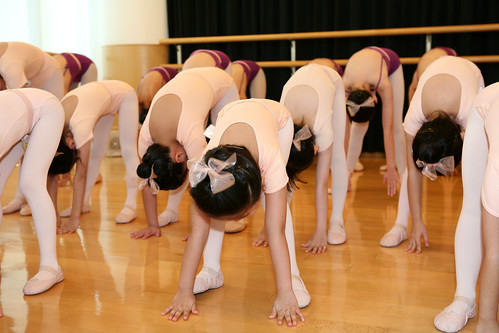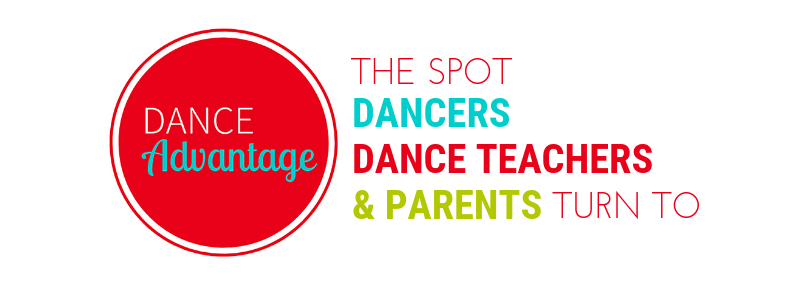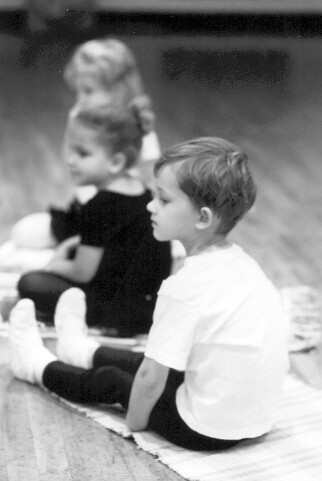Managing, engaging, and interacting with young children in an active setting like a dance class can be extremely challenging.

I have found that classes for dancers under six or seven require the most preparation, the most energy, and the most patience.
A young assistant once stated, “I had this big idea of how the kids would act and how the class would be, and this is more hard work than what I thought.”
She is very right. It is a lot of hard work and a teacher that does it well may seem to know magic the rest of us don’t. But really, it’s all about problem solving.
Below are strategies for dealing with the short attention spans and behavioral challenges typical of the preschool (3-6 years) age group — and maybe even older!
1. Add layers to the movement
When teaching basic dance skills, repetition is important. Keep skill practice interesting by layering your instruction with imagery. Find occasions to play pretend that will also enhance their understanding.
For port de bras exercise, you can ask children to pretend that the wind is blowing their arms out (for demi second), or encourage them to become pancakes and “flip” as they practice three-step turns.
Bringing their attention to a special quality within the movement can improve their focus as well. For example, encourage them to “eat up the space” with large movement in leaps, make their whole body sharp like a knife during marches, or point out the level changes in jumps/sauté and have them try to make their highest level higher each time.
2. Keep the class moving
A common mistake in teaching classes with young children is to spend too much time on a single activity.
For students under six, five minutes on any one thing is usually the maximum. Generally, I try not to spend longer than 10 or 15 minutes in any one formation or on any one portion of the class (in a circle, across the floor, standing in lines, etc.). Children are easily distracted and their attention wanes quickly.
Always plan more activities than you have time to include. If you see that you are “losing them,” do the kids and yourself a favor by wrapping it up and moving on to the next activity.
3. Light up the room
Young kids enrolled in a dance class are there to have fun. It is not yet truly satisfying to “work hard” at something even if they think it will please you.
If it doesn’t feel like playing, they’re far more likely to be inattentive.
Therefore, it is imperative that your energy level be high throughout the class, that you vary the tone of your voice, and that you aren’t afraid to be a bit goofy or over-the-top. You should be the most interesting thing in the room!
Bonus tip on vocal volume: I sometimes like to whisper when students are getting too noisy because it adds an element of surprise and because they have to quiet down to hear me.
4. Participate and model behavior
With older children it is sometimes necessary to limit your demonstration or participation in the actual moving/dancing portions of class.
Young children, however, take all of their cues from you.
If you are asking them to pretend they are in a dark forest as they creep around the room, then you must be in that forest with them at least part of the time.
If you want them to perform with 100 percent of their energy, then you have to give 150 percent.
Modeling behavior is also important for showing children how to behave. Ask the students what is the proper way to sit or stand while waiting on their spot or number, then show them, and then have them practice it with you.
5. Offer “Dancer’s Choice”
The freedom to choose is empowering, particularly for children who are learning to become independent in their thoughts and decisions.
Try to include a chance for your dancers to make a choice at least once in each lesson.
However, be careful about offering unlimited possibilities. Children do best when they have an “either/or” alternative. This can be as simple as occasionally allowing children to choose if they’d like a blue spot or a red spot to stand upon (just make sure when offering these types of choices, you have enough of each so that no child gets “stuck” with something).
Every so often allow the class to vote for doing échappé or balancé for this lesson, practicing the other next week. You can also offer opportunities for children to make decisions in their movement. For instance they may choose between dancing sharply or smoothly (quickly/slowly, happily/sadly) around the room. They may choose to make a round shape or an angled shape (balanced/off-balanced, big/small) when they finish their exercise across the floor.
In fact, this ability to choose is what makes creative dance a powerful introduction to movement and dance for children (and, in fact, all people).
6. Enlist and recruit a misbehaving child
A chronically misbehaving child can be like a little thorn in your side. If you’re familiar with the advice to keep your enemies closer than your friends, this tip is similar.
Instead of constantly reprimanding the child, enlist his/her help in some way. Ask her to be your helper when handing out props, or recruit him to make the check marks in the attendance roster. Sometimes your faith in the student as you offer them this responsibility is all the incentive they need to behave better.
If you can identify the portions of class which are most difficult for this student (during recital practice, across the floor, etc.), these may be your best opportunities for recruitment.
7. Avoid making promises you can’t keep (line leader problem-solving)
Children are a lot like elephants – they never forget!
Therefore, I’ve found it best not to make too many promises that I can’t (or won’t remember) to keep. When there is turmoil over who gets to be line leader, it may seem a grand solution to promise a child that “next week” they’ll be the leader. The problem is that you’ll rarely remember that appeasing promise.
Instead, the victim of your faulty memory will remind you after you’ve already broken your promise and then more promises will need to be made.
Some teachers use a detailed chart or system for choosing line leaders. My solution may not be perfect but I typically choose (at will) a line leader during the warm-up circle. When the decision is made long before the moment of actual leading, it seems to lessen the disappointment of not being chosen.
I make it clear in our classroom rules/procedures that this is a privilege they can lose due to poor behavior. Should this occur, they must choose the new line leader that will take their place. I try to be fair, but my selection process is typically rather arbitrary. When met with discontent, I reply kindly but firmly “I know it is disappointing not to be chosen this time but you’ll get a turn another day!” (Notice I didn’t say “next time.”)
8. Offer positive feedback at every opportunity
Children respond well to positive feedback.
Continually be on the look out for things that are being done well. This gives the class a chance to model the appropriate behavior.
If the majority of the class is messing around, look for that one child who is doing SOMETHING (anything) right and single them out rather than reprimanding the whole class. You’ll definitely get more mileage out of saying something positive (“beautiful arms, Suzie” “that’s a high jump, Becca!”) than overstating negatives.
Try to be specific. “Good job” doesn’t have much power all on its own so really keep your eyes open for specific things that are being done properly.
9. Limit negative attention
A child will eventually stop responding to his/her name if it is said over and over in a negative way. In fact, if a student receives negative responses a lot at home they may already be well-practiced at the skill of “tuning you out.”
Interestingly, you may need to hone your own skills in this area because it is often better to ignore bad or distracting behavior (if no one is getting hurt) than to draw attention to it. Negative words like “No,” “Stop,” and “Don’t” should be used sparingly — usually only when there is risk of danger or injury.
For some children, negative attention is preferable to no attention at all, in other words, they will look for ways of getting your attention if you don’t first give it in a positive manner.
10. Say what you want to see, even if you don’t really see it
For instance, let’s say no one is pointing their toes. Instead of saying “Point your toes!” say “Thank you for pointing your toes!” or “I see beautiful, pointed toes!” and you may be surprised that suddenly the children all point their toes (even if they wouldn’t have if you had specifically asked or told them to).
Use the same method for all kinds of behaviors, including waiting quietly, keeping hands to oneself, quickly changing shoes, etc.
This tip transformed my teaching. The concept may seem obvious, or perhaps just a silly matter of semantics, but it is powerful. I can’t take credit for the “Say and see” wording or concept, however. It comes from one of my favorite resources, Creative Dance for All Ages by Anne Green Gilbert. In fact, many of her ideas have worked their way into my teaching and are likely to show up elsewhere within this list.
11. Assign objectives that heighten anticipation
Repetition and routine are extremely important in a class for children, however, if the same skills are done the same way each week, the children are bound to get bored.
Even if you work on the same skills each week, you can still give the kids creative objective that will increase their anticipation toward participating, As in layering, these “assignments” are easy to change from week to week.
For instance, if you practice gallops across the floor, tell the class they must gallop a special dessert to their friend on the other side. When taking turns, ask each child what kind of dessert they are offering.
Next week, perhaps they’ll take a special balloon to the other side. Just make sure you inform the class of what you’re going to ask and what you expect of them before the exercise. Something to the effect of, “Now we’re going to do brush walks. When it is your turn, I’m going to ask you your favorite color. Keep it a secret until it’s your turn! After you tell me, you can do your walks across the floor and pretend to paint that color with your feet.”
This method gives the children something to look forward to and think about as they wait for their turn.
12. Use distraction and redirection
When children begin to get bored, are tired of waiting, or are seeking attention, they often complain, ask to do something else (like visit the restroom or get water), or fidget.
During moments in which it is important to finish an exercise or task, refocusing your students’ attention, or distracting them is key.
If a student is hounding you for a water break during arabesques be clear and firm that “Right now we’re dancing.” Then, in an energetic tone, swoop in with something that will refocus their attention like, “In fact, I’m pretending to be a beautiful bird while I do my arabesque! What kind of bird are you?”
Waiting for a turn can be difficult, sometimes just having something to hold while standing by can be calming for a child who is forced to sit tight. When asking large classes to take turns crossing the floor, I have offered the next children in line something sensory like scarves (or a stuffed animal) to hold until it is their turn, at which time they pass the object to the person behind them who is waiting.
In a class which has an especially hard time waiting, each child could keep a scarf and you could suggest different ways of using it as they practice a skill.
BONUS TIP!!!
Keep a few things in your “back pocket”
It can be hard even for experienced teachers to phrase things in the clearest way possible, make up creative suggestions or distractions on the spot, or switch gears when needed.
Therefore, think about the skills you practice in class and come up with a few images for each that you can whip out at appropriate moments.
Try to anticipate problems or situations that may arise and rehearse your manner of giving instructions just as you would rehearse the combination that you are giving the class.
Always have a few “crowd pleasers” handy to gather scattered attentions or revive a spiritless mood.
Keep these things in your “back pocket” so that they are there when you need them.
Practicing Magic
Improving skills for working with preschool children is not a magic trick. It comes down to thoughtful practice and assessment of what works and what does not.
Watching a child enjoy dance and get excited about movement — now that is magical!
Whether you are an assistant or a professional, I hope you have found these tips useful in your classes.
Tell me what you think of these 12 tips! Other teachers reading the blog will welcome your thoughts, and so will I!
Nichelle Suzanne is a writer specializing in dance and online content. She is also a dance instructor with over 20 years experience teaching in dance studios, community programs, and colleges. She began Dance Advantage in 2008, equipped with a passion for movement education and an intuitive sense that a blog could bring dancers together. As a Houston-based dance writer, Nichelle covers dance performance for Dance Source Houston, Arts+Culture Texas, and other publications. She is a leader in social media within the dance community and has presented on blogging for dance organizations, including Dance/USA. Nichelle provides web consulting and writing services for dancers, dance schools and studios, and those beyond the dance world. Read Nichelle’s posts.


